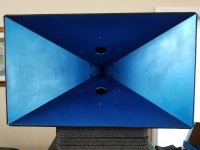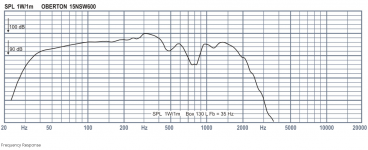You use the word "volume" when I think that you must mean area. The "volume" of a driver (it magnet, frame etc.) is completely irrelevant. Unless you mean Volume Velocity (VV), in which case your statement is wrong - as VV increases the sound level increase but the direct/reverberant ratio does not change. Everything depends on what frequency range we are talking about. At LF only the total VV of the sources is a factor, the radiating areas of the sources makes no difference. This is a direct result of the fact that at LFs the sound wavelengths are so long that the situation is fairly "static" in that the pressure rises and falls virtually uniformly about the space - there is no "directivity" effect whatsoever. Above Schroeder, radiating area is a strong factor, but below, not-so-much.Another thing; What about the effects of system or driver volume on IR. As we increase volume, we hear less room and more of the driver. Soooooo how is that fair to say that source radiation to room reflected energy ratio, is always static, in the omnidirectional spectrum? This is another reason why I would think that increasing radiation area, lowers rooms final contribution. How am I wrong?
Picture a large ball in a larger tub of water. If I move it up and down slowly the water level merely rises and falls. As I increase the frequency waves begin to arise and later modes become apparent.
Yes. That darn volume word, I have used it to talk about radiation area into the sound field, in the past, but this time I mean magnitude of spl... I could of sworn that I watched GD improve with increased volume... almost certain... GD is my backwards engineering way of monitoring accuracy in the Room. Not just GD changed for the better but Decay as well. Thanks for the conversation, I'll be able to take measurements soon. After sharing them maybe we'll see whats going on. The gate of measurement is a likely part of it but even if so, is the change, SQ related.Unless you mean Volume Velocity (VV), in which case your statement is wrong - as VV increases the sound level increase but the direct/reverberant ratio does not change.
Anything that we call "linear" is, by its essence independent of SPL. In the audio world, by far the most dominate "nonlinearity" in the entire reproduction chain is hearing. So it's best to think of everything except perception as being a completely linear phenomena.
Sorry, I meant a pre-wall.View attachment 1110390
Are you sure you sure you really mean a retaining wall? Sorry to be picky but I’m an architect 😀
The response of this woofer is about as linear as it gets. It was available just before the emergence of class H and D amplification.
B&C is a performance/technology based company and does not brag about subjective matters, except in this case:
"Best sound reproduction, excellent flat response to 3kHz."

The response of the modern equivalent:

B&C is a performance/technology based company and does not brag about subjective matters, except in this case:
"Best sound reproduction, excellent flat response to 3kHz."
The response of the modern equivalent:
Here's the 18n862 in a sealed box, that's close to a 21" cube external.
No stuffing, driver isn't bolted in... lol .
Raw, no filters.
Sub is on floor pointing up, with mic 2-3" from dust cap....
Measurement made moments ago...smooth sucker, huh?!
( I'm in the process of seeing how well the driver might work playing thru ports ala a synergy. I lay plates on top the driver with various ports cut into them)

No stuffing, driver isn't bolted in... lol .
Raw, no filters.
Sub is on floor pointing up, with mic 2-3" from dust cap....
Measurement made moments ago...smooth sucker, huh?!
( I'm in the process of seeing how well the driver might work playing thru ports ala a synergy. I lay plates on top the driver with various ports cut into them)
An older B&C 15" as they were available until about the mid-2000s.@Ro808 What is "this woofer"?
Rare in the US and certainly in Canada, so check your PM 😉
Last edited:
It's probably the standard measurement protocol. Perhaps Dr. Geddes knows.
While it may seem overly smooth, B&C isn't known for dressing up, contrary to some other companies.
This is another 15" driver from the same era.

This is an independent imp. plot of a B&C DE500 compression driver behind a short waveguide. Also fairly smooth.

Same waveguide + B&C DE250 (different scaling):

Same waveguide + my RCF driver (different scaling):

While it may seem overly smooth, B&C isn't known for dressing up, contrary to some other companies.
This is another 15" driver from the same era.
This is an independent imp. plot of a B&C DE500 compression driver behind a short waveguide. Also fairly smooth.
Same waveguide + B&C DE250 (different scaling):
Same waveguide + my RCF driver (different scaling):
Last edited:
I have never found B&C to be wrong in their measurements (which is hardly the norm in the industry.)
The red plot above clearly has some reflections in it. One would nee to see the IR.
The red plot above clearly has some reflections in it. One would nee to see the IR.
I'm in the process of seeing how well the driver might work playing thru ports ala a synergy. I lay plates on top the driver with various ports cut into them.
A Jericho J1-94 clone? 😉 (Still my favorite Danley Product).
I believe a stripped down redesign could potentially make it a very capable hi-fi or studio speaker. A single BMS 4594Nd + 4x 4" or 6" + 4x 15" or 18" should suffice. And while it works, I'd rather get rid of the combiner and instead optimize the throat section and possibly add curvature to the horns.
I'd probably also convert the low section to this; remove 2 and bring the remaining 4 closer together:
Last edited:
You think big, my friend !!! Too big for me 🙂A Jericho J1-94 clone? 😉 (Still my favorite Danley Product).
I believe a stripped down redesign could potentially make it a very capable hi-fi or studio speaker. A single BMS 4594Nd + 4x 4" or 6" + 4x 15" or 18" should suffice. And while it works, I'd rather get rid of the combiner and instead optimize the throat section and possibly add curvature to the horns.
I'd probably also convert the low section to this; remove 2 and bring the remaining 4 closer together:View attachment 1111323
I'm toying with the idea of adding two 18"s onto the sides of the synergies as i now make them. They would need to be a little larger than this 36"x22" mouth size, and I'd have to enclose the 18"s...so it would be a heavy immobile beast. @ncbluetj's BASH thread has me all fired up.

The idea for now is use the same drivers, and the same 90x60 horn: BMS 4594HE, four B&C 4NDF34", two 10"s or 12"s (not which sure yet), and two non-vented 18n862's.
I like syns at ear height when standing (did away with a listening chair 20 years ago lol).
They currently sit on top 48" tall, dual 18 push-push reflex subs.
If i use the dual 18"s in the new syns, I lose the stands ...big bummer. Guess I'll need to set them on either a Labhorn or JTR Orbitshifter (never could bring myself to sell the PA subs) But that brings the speaker up to a 6-way...yikes and ugh.....
On the positive side however, that would solve/eliminate any potential need to vent the 18"s mounted in the synergy (for trying to keep full linear SPL down to 30Hz)
Last edited:
Hi Mark
How about building your SYN 11´s with a removable box (on wheels) underneath the SYN 11, that provides volume for the 18´s! You could even make some low tuned reflex-ports in the "volume"-boxes near the horn-mouth and still be within 1/4 wavelength with the ports! 🤔
I am looking forward to your SYN 11 thread. 😀
Steffen
If i use the dual 18"s in the new syns, I lose the stands ...big bummer
How about building your SYN 11´s with a removable box (on wheels) underneath the SYN 11, that provides volume for the 18´s! You could even make some low tuned reflex-ports in the "volume"-boxes near the horn-mouth and still be within 1/4 wavelength with the ports! 🤔
I am looking forward to your SYN 11 thread. 😀
Steffen
Hi Steffen,Hi Mark
How about building your SYN 11´s with a removable box (on wheels) underneath the SYN 11, that provides volume for the 18´s! You could even make some low tuned reflex-ports in the "volume"-boxes near the horn-mouth and still be within 1/4 wavelength with the ports! 🤔
I am looking forward to your SYN 11 thread. 😀
Steffen
That's a very interesting idea !
In the application for which they are intended - very high broadband SPL for large venues - the Danley designs are exemplary. But as playback monitors in small venues, I much prefer simplicity when these incredibly high SPLs are not required; i.e minimize crossovers (they can never be ideal, but are necessary,) optimize HF polar pattern with minimal shape divergences in and around the waveguide with proper DI match at the crossover. I thought that's where this thread was heading, but perhaps not. The drift into this audio fantasy world is not very interesting to me. Sorry.
- Home
- Loudspeakers
- Multi-Way
- Is it possible to cover the whole spectrum, high SPL, low distortion with a 2-way?
